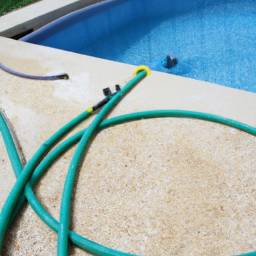Draining a Pool How-To with Garden Hose
Table of Contents []
How To Drain Inground Pool With Garden Hose
Introduction
Every home pool owner wishes to maintain their luxury oasis, but it can be challenging to handle the water maintenance by yourself. Whether you'd like to learn how best to keep your water levels low or avoid issues like algae growth, draining an in-ground pool is a great place to start. Draining an in-ground pool with a garden hose is the simplest approach you can achieve, and with the help of the tips provided in this article, you'll be able to handle the job yourself. We'll discuss important information such as the appropriate water levels, why and how to control them, safe draining solutions and the current laws imposed by some municipalities, amongst other relevant topics.
How to Drain Inground Pool With Garden Hose
When done properly, draining an in-ground pool with a garden hose is relatively simple. Let's take a look at some of the basics:
1. Identify the Garden Hose to be Used: Make sure you have a garden hose long enough for your desired pool draining. Make sure it is in good working condition, secure any connections, and double check for any potential blockages.
2. Locate the Drain Valve: This is typically located near the bottom and requires the use of a screwdriver to loosen the nuts, slowly releasing the water. However, if your pool has an overflow drain, simply attach the garden hose to the bottom.
3. Determine Pool Water Level: Ensure the water is below the inlet and outlet levels. Pour a non-reactive filler like sand into the pool until it meets the desired level.
4. Assembly and Position: Ensure the hose is secured tightly and pointed towards the nearest drain. Begin by running the hose and watching the gauge on the valve, be sure to not exceed safe levels.
5. Dispose of Water Properly: Be certain to dispose the pool water according to regulations, where applicable. Check to make sure all the water has been run out and you're done.
Why You Should Drain Your Pool
Owners of an in-ground swimming pool may decide to drain it due to a number of reasons, such as:
Algae Accumulation: Without regular maintenance, algae can start to accumulate, causing the water to turn an unattractive green color.
Unbalanced Chemistry: Too much calcium can cause the water to reach unsuitable levels, leading to scaling on the equipment or interior surfaces, as well as on the walls or pillars of the pool.
Damages to the Pool: If the water level is too high, it can cause structural damages to the pool, due to water pressure or settling.
Poor Building Codes: According to certain building codes, it may be necessary to drain your pool to reposition a fence or other enclosure.
Maintenance: Even without the above issues, it's important to drain the pool and add fresh water every three to four years to ensure safe swimming conditions.
Local Municipality Regulations
In most cases, municipalities and states mandate that the pool water be drained safely into a sanitary sewer. The pool water must never be drained into a street, storm drain, lake, or other body of water, and you should always seek written permission before disposing of your pool water in another way. This process may require the assistance of a professional remodeler or contractor for special cases and requires pool owners to pass inspections as well as pay associated fees.
Summary
Draining an in-ground pool is a simple process that can be accomplished through the use of a garden hose. It is an important part of keeping your pool in prime condition, as too much calcium or algae will cause structural damages as well as an overall distasteful swimming experience. When draining, make sure to keep the water level below the inlet and outlet levels, dispose of the water according to local regulations, and always run the hose until all the water has been released.

Previous Page
Next Page
